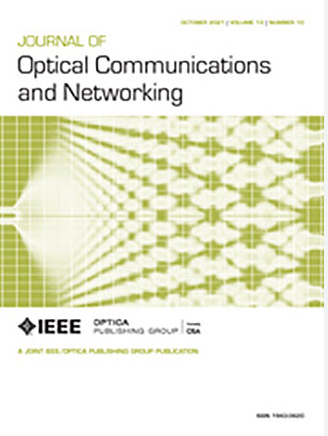Optimal placement of multi-wavelength integrated tunable transmitters in reconfigurable optical data center interconnection networks with multi-hop routing
IF 4.3
2区 计算机科学
Q1 COMPUTER SCIENCE, HARDWARE & ARCHITECTURE
引用次数: 0
Abstract
Circuit-switched technologies have created the enticing possibility of guaranteeing the performance of data center networks under bursty and skewed traffic. In our prior work [J. Opt. Commun. Netw.16, 990 (2024)], we proposed to use multi-wavelength integrated tunable transmitters (MWITTs) to provide dynamic capacity sharing in modular arrayed waveguide grating-based interconnection networks. However, with one-hop routing, the scope of wavelength sharing is limited, and the required number of MWITTs to maintain good performance will increase drastically when hotspot top-of-racks are distributed sparsely. In this paper, we propose expanding the scope of dynamic capacity sharing of MWITTs by incorporating a multi-hop routing mechanism, such that fewer MWITTs are needed to achieve comparable performance levels. We model the problem of the placement of MWITTs with multi-hop routing into a binary quadratic-constrained linear programming problem. Two feasible placements, namely, star-topology placement and interconnected-group placement, are proposed and proved optimal in specific scenarios. Furthermore, an efficient heuristic algorithm combined with the above two feasible placements, the simulated annealing-based MWITT placing algorithm (SAMPA), is proposed to solve this placement problem. Results show the high accuracy and low computational complexity of SAMPA. We compare the minimum number of required MWITTs and the blocking probability under one-hop and multi-hop routing through simulation to prove that multi-hop routing can achieve better performance with fewer MWITTs. The number of MWITTs is 128 and 30, to achieve the blocking probability of 0.0169 and多跳路由可重构光数据中心互连网络中多波长集成可调谐发射机的优化配置
电路交换技术为保证数据中心网络在突发和倾斜流量下的性能创造了诱人的可能性。在我们之前的工作中[J]。选择,Commun。网络[j] .16, 990(2024)],我们提出使用多波长集成可调谐发射机(MWITTs)在基于模块化阵列波导光栅的互连网络中提供动态容量共享。然而,在单跳路由中,波长共享的范围有限,当热点稀疏分布时,保持良好性能所需的mwitt数量将急剧增加。在本文中,我们建议通过结合多跳路由机制来扩大mwitt动态容量共享的范围,这样就可以用更少的mwitt来达到相当的性能水平。我们将多跳路由的mwitt的布置问题建模为一个二元二次约束线性规划问题。提出了两种可行的布局方案,即星型拓扑布局和互联群布局,并在特定场景下证明了这两种方案的最优性。在此基础上,提出了一种结合上述两种可行布局的高效启发式算法——基于模拟退火的MWITT布局算法(SAMPA)来解决这一布局问题。结果表明,该方法精度高,计算复杂度低。通过仿真比较了单跳路由和多跳路由下所需最小mwitt数和阻塞概率,证明了在mwitt较少的情况下,多跳路由可以获得更好的性能。在128机架互联网络中,当业务量突发度为0.5,业务量偏度为0.6,热点机架数为16时,单跳路由和多跳路由的阻塞概率分别为0.0169和$1.4 \times{10^{- 3}}$。
本文章由计算机程序翻译,如有差异,请以英文原文为准。
求助全文
约1分钟内获得全文
求助全文
来源期刊
CiteScore
9.40
自引率
16.00%
发文量
104
审稿时长
4 months
期刊介绍:
The scope of the Journal includes advances in the state-of-the-art of optical networking science, technology, and engineering. Both theoretical contributions (including new techniques, concepts, analyses, and economic studies) and practical contributions (including optical networking experiments, prototypes, and new applications) are encouraged. Subareas of interest include the architecture and design of optical networks, optical network survivability and security, software-defined optical networking, elastic optical networks, data and control plane advances, network management related innovation, and optical access networks. Enabling technologies and their applications are suitable topics only if the results are shown to directly impact optical networking beyond simple point-to-point networks.

 求助内容:
求助内容: 应助结果提醒方式:
应助结果提醒方式:


